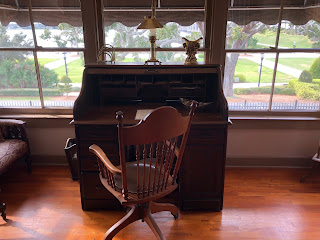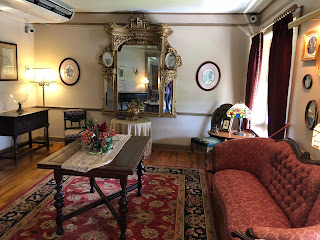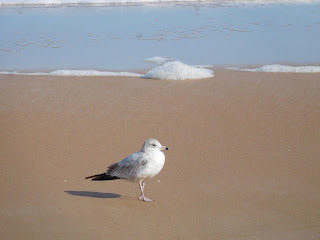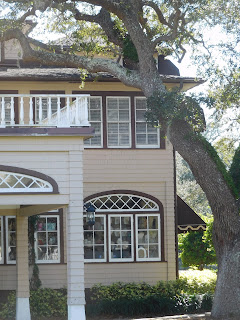It's been said that in Florida, "North is South and South is North."
The southern part of the Sunshine State--particularly Miami, Fort Lauderdale and Tampa--is filled with retirees and other transplants from colder climes, like the one in which I live. The north, on the other hand--which includes the Panhandle and, depending on which definition you choose, anything north of Orlando--has more in common, genealogically and culturally, with Georgia or Alabama.
My parents live in the north-central part of the state, near Daytona Beach. In cities like Palm Coast, where my parents live, or Daytona or Ormond Beach, there are people like my folks who moved from places north of the Potomac. But outside of such cities, in the smaller towns and rural areas, the "good ol' boys" rule the roost.
Some native Floridians will tell you that in those towns, and in the surrounding countryside, you will find the "real" Florida.
Now, I am in no position to say that. But I can say that it's certainly more Southern than, ironically, some points further south.
I mean, you're not going to find anything like this along Collins Avenue in Miami Beach:
Of course, the moss hanging from the trees is a sign you're in Dixie. But that's not the only thing that made my first ride on this path, more than two decades ago, one of my first truly Southern experiences in Florida. It's also where I saw my first armadillo.
That path also is the entrance to the Bulow Plantation Ruins Historic Site. It is interesting to learn about the rise and fall of a plantation--and a society. But its exhibits and signage reflect a bias that I've found in every other former plantation site I've visited: It makes the building and operation of the plantation (and its sugar refinery) seem like a heroic act because the owners had to face, not only capricious Nature, but hostile Natives. According to the text of the exhibits, the plantation was "swept away" in the Seminole War of 1836.
And, of course, the labor practices are whitewashed, if you know what I mean.
But it's certainly worth a visit, not only for the ruins and history lesson, but also to bike, hike, fish or simply be calm in a setting that is reverting to nature.
From the Bulow Plantation, I rode down Old Kings Road into Volusia County and made a right where the road ends--at the Old Dixie Highway. Then I got to ride under more canopies of moss-draped trees--for about four miles! Even if you are thinking about the history of the place, it's definitely a lovely ride. And I found the drivers unusually courteous: All gave me a wide berth and none honked. It didn't matter whether the vehicles were Fiats or trucks, or whether they had license plates from Florida or New Jersey or Ontario or Michigan. I guess anyone who drives on that road isn't in a hurry--and shouldn't be.
Along the way, I stopped to see something that made me think, oddly enough, of the Ta Prohm temple I saw in Cambodia.
People know it as the "Tomb Raider" temple. It's the one in which tree roots have wrapped themselves around its walls. Now, of course, you're never going to find anything that looks like an Angkor Wat temple in Florida, or anywhere else in the US. But seeing the Fairchild Oak in Bulow Creek State Park made me think of what those trees in Cambodia might have done if they didn't have a temple to ravel themselves around.
It's easy to see why stories by writers like Faulkner and Welty are so often so intricate that they seem (or are) tangled. That idea occured to me after leaving Bulow Creek and continuing along the Old Dixie Highway as it bisected a swamp and curved along the shore of the Halifax River on its way to Ormond Beach.
The southern part of the Sunshine State--particularly Miami, Fort Lauderdale and Tampa--is filled with retirees and other transplants from colder climes, like the one in which I live. The north, on the other hand--which includes the Panhandle and, depending on which definition you choose, anything north of Orlando--has more in common, genealogically and culturally, with Georgia or Alabama.
My parents live in the north-central part of the state, near Daytona Beach. In cities like Palm Coast, where my parents live, or Daytona or Ormond Beach, there are people like my folks who moved from places north of the Potomac. But outside of such cities, in the smaller towns and rural areas, the "good ol' boys" rule the roost.
Some native Floridians will tell you that in those towns, and in the surrounding countryside, you will find the "real" Florida.
Now, I am in no position to say that. But I can say that it's certainly more Southern than, ironically, some points further south.
I mean, you're not going to find anything like this along Collins Avenue in Miami Beach:
Of course, the moss hanging from the trees is a sign you're in Dixie. But that's not the only thing that made my first ride on this path, more than two decades ago, one of my first truly Southern experiences in Florida. It's also where I saw my first armadillo.
That path also is the entrance to the Bulow Plantation Ruins Historic Site. It is interesting to learn about the rise and fall of a plantation--and a society. But its exhibits and signage reflect a bias that I've found in every other former plantation site I've visited: It makes the building and operation of the plantation (and its sugar refinery) seem like a heroic act because the owners had to face, not only capricious Nature, but hostile Natives. According to the text of the exhibits, the plantation was "swept away" in the Seminole War of 1836.
And, of course, the labor practices are whitewashed, if you know what I mean.
But it's certainly worth a visit, not only for the ruins and history lesson, but also to bike, hike, fish or simply be calm in a setting that is reverting to nature.
From the Bulow Plantation, I rode down Old Kings Road into Volusia County and made a right where the road ends--at the Old Dixie Highway. Then I got to ride under more canopies of moss-draped trees--for about four miles! Even if you are thinking about the history of the place, it's definitely a lovely ride. And I found the drivers unusually courteous: All gave me a wide berth and none honked. It didn't matter whether the vehicles were Fiats or trucks, or whether they had license plates from Florida or New Jersey or Ontario or Michigan. I guess anyone who drives on that road isn't in a hurry--and shouldn't be.
 |
| Toto, I've a feeling we're not in Florida! |
Along the way, I stopped to see something that made me think, oddly enough, of the Ta Prohm temple I saw in Cambodia.
People know it as the "Tomb Raider" temple. It's the one in which tree roots have wrapped themselves around its walls. Now, of course, you're never going to find anything that looks like an Angkor Wat temple in Florida, or anywhere else in the US. But seeing the Fairchild Oak in Bulow Creek State Park made me think of what those trees in Cambodia might have done if they didn't have a temple to ravel themselves around.
It's easy to see why stories by writers like Faulkner and Welty are so often so intricate that they seem (or are) tangled. That idea occured to me after leaving Bulow Creek and continuing along the Old Dixie Highway as it bisected a swamp and curved along the shore of the Halifax River on its way to Ormond Beach.
























































